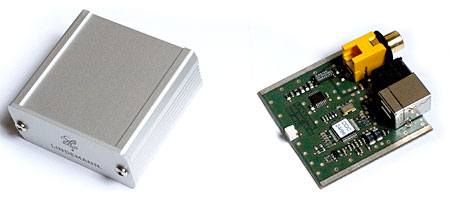| Columns Retired Columns & Blogs |
Lindemann & Stello USB-S/PDIF converters Page 2
The DDC-24/96 is powered from the computer's USB bus, with a red LED indicating when it is powered up; it works with both Macs and Windows machines, and no driver program needs to be installed. When you plug the Lindemann converter into the computer, it identifies itself as "USB DDC 24/96," and dual-mono volume sliders and a Mute button appear in the audio control utility's setup window. My Mac's USB Prober indicated that the USB-DDC 24/96 is manufactured by "Lindemann audiotechnik GmbH" and that it will operate at sample rates of from 32 to 96kHz, but, like the Stello U2, not at 88.2kHz. Bit depths offered are 16 or 24, and a digital volume control is included, which makes it appear that Lindemann uses a version of the Tenor chip seen in the Stello U2.


Listening
I used two different D/A converters to compare the Lindemann and Stello converters with the Bel Canto USB Link 24/96: the Benchmark DAC 1 and the older Musical Fidelity X-24K. I also ran the converters straight into the NAD M2 Direct Digital integrated amplifier. In addition, I compared each of them feeding the dCS Puccini SACD player ($17,000), used as a D/A converter, with the dCS Puccini U-Clock ($5000), which offers a true asynchronous USB input. All four USB-S/PDIF converters were connected with a 9" Stereovox datalink. Files were played with iTunes 9.0.3 running on my Mac mini. My comments apply to what I heard from the converters when used with all four DACs, but in general, the differences were smallest with the Puccini and largest with the Musical Fidelity. To my surprise, the differences with the Benchmark were larger than I expected, given that DAC's jitter-rejecting circuit topology. In absolute terms, the dCS U-Clock feeding the dCS Puccini DAC gave the best sound quality, though all three converters directly driving the NAD amplifier were not far behind.
As good as it sounded using 44.1kHz files, the Bel Canto's soundstage was a little flattened in direct comparison with the Stello and Lindemann, and its presentation had reduced LF extension and a slightly less-defined upper bass. The double bass on Astral Weeks: Live at the Hollywood Bowl, Van Morrison's 2009 revisiting of his classic 1968 album (from CD, Listen to the Lion 93423), was a little too generous in terms of LF bloom through the Bel Canto compared to the other two converters, both of which gave the instrument's sound better-defined leading edges. The same things were true for Nicky Scott's more reticently balanced bass guitar on Van's 1994 A Night in San Francisco (from CD, Polydor 314 521 289-2), which was just that bit better defined with the Lindemann. And through the Stello it acquired a touch more midbass weight, which worked best with the rather dry-sounding Benchmark DAC1.
With the Puccini used as a D/A converter for 44.1kHz data, the asynchronously connected dCS U-Clock initially sounded a little quieter—but then I realized that it was actually just sounding less strident, with a greater sense of ease than the other three USB converters. The U-Clock offered even better-defined, deeper-sounding low frequencies, less midrange grain, and a silkier treble—as should be expected for eight to sixteen times the others' prices. After the U-Clock, my preference was for the Stello, then the Lindemann, then the Bel Canto.
Handling hi-rez audio, the Bel Canto has the advantage in that it will correctly process 88.2kHz data, whereas the Lindemann and Stello must rely on the host computer to up- or downsample it in real time to 96kHz or 48kHz. Either degrades the sound to a quality below that of good CD sound. But with 96kHz data, such as the Beatles' Love (from DVD-A, Apple/Capitol 3 79810 2 5), both the Stello and Lindemann converters gave excellent sound. Perhaps the Stello gave slightly more soundstage depth with the bird sounds that accompany the a cappella "Because." Perhaps. Perhaps the Lindemann was a bit better at differentiating the sound effects at the end of "I Am the Walrus." Perhaps. I am talking small differences here, but ultimately, with 96kHz files, my preference was still for, first, the Stello, then the Lindemann, then the Bel Canto. And it is fair to note that, with both the dCS and Benchmark DACs, the Bel Canto converting 24/96 data sounded more palpable than the Stello converting CD data.
Summing Up
Having used the Bel Canto USB Link 24/96 ($249) for a year at the time of writing this review, I am very appreciative of its merits. But overall, it is outclassed by both the Lindemann and Stello converters—particularly by the latter, which gave a little more sense of ease to the decoded sound than the Lindemann. As the Stello U2 costs $349 compared with $650 for the Lindemann USB-DCC 24/96, and uses much the same technology, that would seem to make the Stello the best buy. But it's not that simple—neither the Lindemann nor the Stello can cope with 88.2kHz data, which the Bel Canto does handle correctly.
Were the Lindemann more competitively priced, I would recommend it, but if all you intend to play are CD-quality files, then the industrial-looking Stello gets my recommendation. Otherwise, the Bel Canto USB Link 24/96 is the one to choose, provided you have a DAC that offers good jitter rejection.
- Log in or register to post comments




































